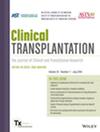Skin Elasticity: A Potential Surrogate Marker for Facial Allograft Skin Fibrosis—A Case Series
Abstract
Introduction
Rejection represents a major and common complication in vascularized composite allotransplantation (VCA). Over time, recurrent acute or chronic rejection can lead to vascular and dermal fibrosis and potentially graft loss. To date, a non-invasive monitoring tool to capture chronic graft changes among VCA recipients has not been established. This pilot study aims to assess the potential value of noninvasive skin elasticity measurements for surveillance of longitudinal fibrosis of facial allografts.
Methods
Viscoelasticity was non-invasively assessed via triplicate measurements of the transplanted facial skin on bilateral cheeks and native skin on bilateral upper arms in six face transplant recipients using the well-established Cutometer Dual MPA 580. Data were statistically compared with recipient/donor age, post-transplant years (PTYs), and cumulative rejection burden (CRB), smoking status, ethnicities, and immunosuppressive regimens.
Results
A significant (p < 0.05) negative linear relationship between CRB and the Cutometer parameters R2 (gross elasticity), R5 (net elasticity), and R7 (elasticity recovery) was found, which was not observed in control measurements of native skin of VCA recipients. Results were ranked into a three-level severity scale. Comparison with PTYs further revealed a significant negative linear relationship with R2 and R5 values. No statistically significant correlation was detected across R values when evaluated against recipient/donor age, smoking status, ethnicity, or immunosuppressive regimens.
Conclusions
Although diagnosis and monitoring of rejection-associated degenerative skin changes currently still rely on biopsies, this exploratory study identifies skin elasticity as a promising surrogate marker for facial allograft fibrosis.

 求助内容:
求助内容: 应助结果提醒方式:
应助结果提醒方式:


